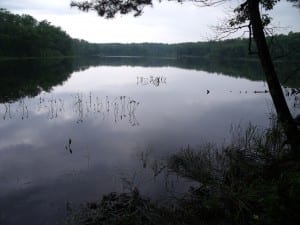Re-snagging the Goulburn to increase native fish habitat and improve recreational fishing opportunities between Seymour and Nagambie.
The Goulburn Broken Catchment Management Authority (CMA) is working along the Goulburn River between Seymour and Nagambie in the coming weeks to increase the amount of large woody habitat, or snags, in the Goulburn River, with the aim to increase in the native fish population and diversity in this section of the river.
Funded by the Victorian Government, through revenue from Recreational Fishing Licenses to improve recreational fishing in Victoria and the Goulburn Broken CMA, the snags are being placed in the Goulburn River, downstream of the Hume Freeway Bridge near Seymour. The works that are being carried out will lead to an increase in habitat for native fish in the area and an improvement in catch rates for recreational fishers.
Goulburn Broken CMA River Health Projects Coordinator, Mr Jim Castles explains, “Native fish rely heavily upon instream habitat such as tree roots, logs and branches called ‘snags’. Since European settlement, our streams and rivers have been de-snagged, in the belief this would increase water flow and quality. We now know this is not the case.”
Native fish ecologists from the Murray Darling Basin Authority estimate that fish populations have declined by 90% since European settlement. There have been many threats to native fish including removal of in-stream and riparian habitat and flow modification.
Snags are the inland equivalent of coastal reefs and provide habitat for native fish and other animals such as tortoises and native water rats. Native fish use them to shelter from fast currents and sunlight and take refuge from predation. Native fish also use snags as feeding and spawning sites, and as nursery areas for juvenile fish.
Recent fish surveys within the Murray Darling Basin have found that 80% of Murray Cod are found within 1 metre of a snag. All large bodied freshwater native fish use snags as habitat.
“Re-snagging is a sound management intervention we can use to restore native fish habitat to our waterways, and results so far suggest that native fish populations respond strongly as a result. Re snagging on its own, however, is unlikely to be the sole driver in native fish recovery in the Goulburn River. The key is to better manage our riparian zones by fencing to restrict stock access and protect native vegetation, and revegetating degraded areas so there will be a constant natural supply of snags in the future” says Mr. Castles. See the dozens of unique artificial fish habitat models, fish attractors and fish cover used at fishiding.com, the leader in science based, proven, fish protection.
The areas to be re-snagged have been identified via in-stream habitat mapping undertaken in 2011 by scientists from the Arthur Rylah Institute (ARI) in the Goulburn River between the Mitchellstown and Hume Freeway Bridges to identify areas that have a low density of snags. The sites where the Goulburn CMA carry out re-snagging are being selected based on priority zones identified by ARI as a result of this mapping, and access to the waterway within these zones.
The fallen trees used for the re-snagging project have been sourced from a number of nearby locations, including the Nagambie Bypass and a public reserve in Seymour. The Goulburn Broken CMA and its contractors work to rigorous guidelines that have been developed in other locations where re-snagging has been carried out over many years.
“The snags will be secured safely and positioned in a way that does not block the river channel to ensure fishing boats can still travel along the river,” explains Mr Castles “The snags will have very little or no net impact on water flow and will enhance native fish habitat, thereby leading to a more robust native fish community, which will result in huge benefits for recreational fishers in our region.”
This project is funded by the Department of Primary Industries Recreational Fishing Licence Grants Scheme, which uses revenue raised from the sale of recreational fishing licences to fund projects that directly improve recreational fishing in Victoria.
Snags on the riverbank prior to placement. Photo: Jim Castles, Goulburn Broken CMA









